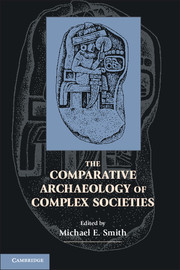Book contents
- Frontmatter
- Contents
- Tables
- Figures
- Contributors
- Foreword
- Preface
- Chapter 1 Comparative Archaeology
- Chapter 2 Approaches to Comparative Analysis in Archaeology
- Chapter 3 Comparative Frames for the Diachronic Analysis of Complex Societies
- Chapter 4 What It Takes to Get Complex
- Chapter 5 Challenges for Comparative Study of Early Complex Societies
- Chapter 6 Patterned Variation in Regional Trajectories of Community Growth
- Chapter 7 The Genesis of Monuments in Island Societies
- Chapter 8 Power and Legitimation
- Chapter 9 The Strategies of Provincials in Empires
- Chapter 10 Household Economies under the Aztec and Inka Empires
- Chapter 11 Low-Density, Agrarian-Based Urbanism
- Chapter 12 Archaeology, Early Complex Societies, and Comparative Social Science History
- Index
- References
Chapter 7 - The Genesis of Monuments in Island Societies
Published online by Cambridge University Press: 07 October 2011
- Frontmatter
- Contents
- Tables
- Figures
- Contributors
- Foreword
- Preface
- Chapter 1 Comparative Archaeology
- Chapter 2 Approaches to Comparative Analysis in Archaeology
- Chapter 3 Comparative Frames for the Diachronic Analysis of Complex Societies
- Chapter 4 What It Takes to Get Complex
- Chapter 5 Challenges for Comparative Study of Early Complex Societies
- Chapter 6 Patterned Variation in Regional Trajectories of Community Growth
- Chapter 7 The Genesis of Monuments in Island Societies
- Chapter 8 Power and Legitimation
- Chapter 9 The Strategies of Provincials in Empires
- Chapter 10 Household Economies under the Aztec and Inka Empires
- Chapter 11 Low-Density, Agrarian-Based Urbanism
- Chapter 12 Archaeology, Early Complex Societies, and Comparative Social Science History
- Index
- References
Summary
One important way archaeologists examine past social relationships is by studying durable monuments. Monuments, such as elaborate tombs, large temples, and elite palaces, are usually the products of complex societies, where they serve as testimonies of social authority and prestige. Unlike more private forms of architecture such as houses, monuments serve as public focal points and places of community interaction, built to communicate very specific meanings about how to become a member of a larger social whole, how to interact collectively. Their more complex architectural grammars (with plazas, expansive doorways, or passageways) create a spatial map that is acted on through movement, translated through spatial experience, and physically communicated by anchoring social meanings in space. And as individuals move around or through monumental spaces, they experience and translate these public meanings.
One of the most critical dynamics of large public monuments is the act of their physical construction. A motivated labor force orchestrating and executing a coordinated building plan represents no better example of how to generate collective thought. Up to thousands of laborers were utilized in constructing the most sophisticated and greatest of the world’s monuments, demonstrating that as the size and complexity of a monument begins to exceed its practical function, so does its collective vision and symbolism expand. Monumental architecture directly communicates, in a public and enduring fashion, that the greater the monument the more orchestrated the collective effort involved. And as a form of collectiveness they create social messages that are fundamentally different than those conveyed by the domestic house. Monuments steer individuals away from any notions of privacy through discourses of the collective public.
- Type
- Chapter
- Information
- The Comparative Archaeology of Complex Societies , pp. 138 - 164Publisher: Cambridge University PressPrint publication year: 2011
References
- 2
- Cited by

